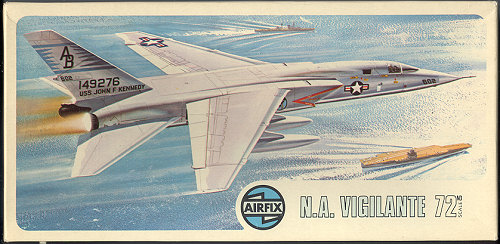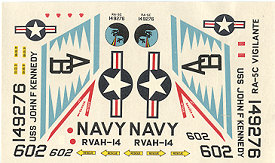
| KIT: | Airfix 1/72 RA-5C Vigilante |
| KIT #: | 04012 |
| PRICE: | $long out of production |
| DECALS: | One option |
| REVIEWER: | Scott Van Aken |
| NOTES: |

| HISTORY |
The Vigilante, designed and built for the U.S. Navy by North American Aircraft Division at Columbus, Ohio, was the only Mach 2 bomber to serve aboard a Navy carrier. Initially designated the A3J-1 attack bomber, it was one of the largest and heaviest aircraft ever accepted for service aboard U.S. Navy carriers. Production began in 1956 and it entered squadron service in June 1961. It was redesignated the A-5 and fully deployed by August 1962, when the USS Enterprise, the Navy's first nuclear aircraft carrier, made its inaugural cruise.
Changing defense strategies marked a change of focus away from carrier-based, heavy attack squadrons. In 1964, all the Vigilantes were reconfigured as reconnaissance aircraft and designated RA-5C. Reconnaissance gear was mounted in what had been the Vigilante's bomb bay. Other modifications allowed the RA-5C to carry four external fuel tanks. These additions increased the airplane's range on reconnaissance missions and allowed it to keep its attack capability with externally mounted bombs and rockets.
The RA-5C Vigilante first flew on June 30, 1962, and was capable of all-weather, long-range, carrier- or land-based, multisensor, reconnaissance missions involving high-altitude supersonic, or very low-altitude, high-speed penetrations. Its inertial navigation system provided the precise position location information demanded. The Vigilante pilot and the reconnaissance/attack navigator (RAN) sat in tandem under individual clamshell-type canopies. The RAN controlled all reconnaissance functions, although the pilot could assume control of the oblique-mounted serial frame cameras. Each crewmember had a catapult/rocket-powered ejection seat, also designed and produced at the Columbus facility, capable of high-altitude, high-speed, or ground-level recoveries.
The combination of the RA-5C Vigilante's ability to deliver conventional weapons, day or night in all kinds of weather, as well as to complete tactical reconnaissance missions made it one of the most versatile aircraft in the world. RA-5Cs served throughout the Vietnam War and were retired from service in 1979.
| THE KIT |
 Thanks to the recent Trumpeter issue, there are now three 1/72 RA-5Cs available to modelers. Besides this one, there is also the Hasegawa version. Now I'm not sure which was first or which of the two earlier kits is the 'best', as both the Airfix and Hasegawa kits have their moments and both are from about the same period of time; the late 1960s/early 1970s.
Thanks to the recent Trumpeter issue, there are now three 1/72 RA-5Cs available to modelers. Besides this one, there is also the Hasegawa version. Now I'm not sure which was first or which of the two earlier kits is the 'best', as both the Airfix and Hasegawa kits have their moments and both are from about the same period of time; the late 1960s/early 1970s.
Molded in white plastic with raised panel lines and other details, the Airfix kit provides a rather basic interior with seats that look more appropriate to the living room than a supersonic recce birds. Of course, there are crew members to place in there, though one really won't see much through the thick clear bits. For some reason, the forward canopy is separate, though there is no means to hold it open. At this point I should point out that some of the pieces had sink areas, most notably on the aft fuselage inserts and the gear doors. I also found ejector pin marks on some bits, the one on the one-piece nose gear/wheel probably the most difficult to fix.
The fuselage is split vertically with separate sections for the rear. This is to allow the builder to install the operating tail hook and movable stabilators, though one would be wise to cement these firmly in position as there is no hook well, only an opening. Wings are mostly one piece with a small inner section that has the slots for the wing pylons already installed. Like the Hasegawa kit, the wheel wells are small in that the doors normally closed are so molded. The camera 'canoe' is separate and once the clear bits are glued in place, is simply attached to the bottom of the fuselage. The wing pylons carry four fuel tanks, which to my eyes are too round on the front with fins that are way too small.
fuel tanks, which to my eyes are too round on the front with fins that are way too small.
Couple of other notes. This aircraft has the curved intakes, though making them flat would be quite simple. It is also from the first batch as there is no additional strake attached to the inner wing as on the second builds. Instructions are typical of Airfix of the period with 11 construction steps and color information given in generic and Airfix paints. Markings are provided for one aircraft from RVAH-14 aboard the USS JFK as shown on the box art. This is one of the first series of RA-5Cs so the markings do match the kit. Despite their age, the decals do look as if they would be quite usable, though it is always wise to test one of these older markings before getting too involved.
| CONCLUSIONS |
I'm not sure if Airfix will reissue this one or not. With Hasegawa having a similar kit and Trumpeter having one that is much newer in terms of technology, perhaps we'll not see this again. Regardless, it will make for a nice model and is worth picking up if you see one on a vendor's table at a show.
Thanks to me for this one.
May 2007
If you would like your product reviewed fairly and fairly quickly by asite that has over 350,000 visitors a month, please contactme or see other details in the